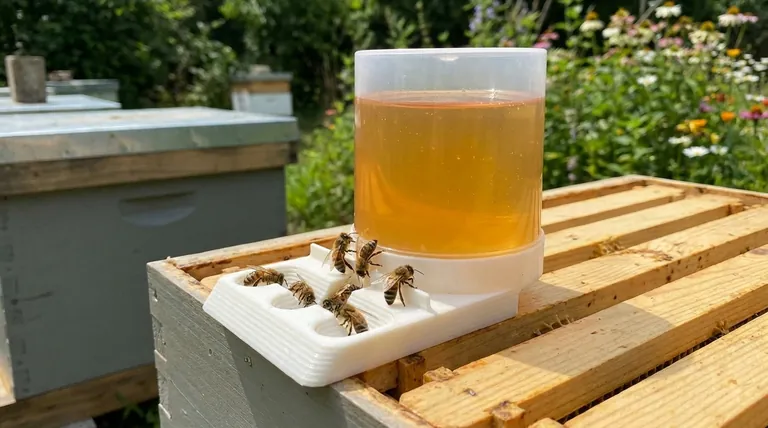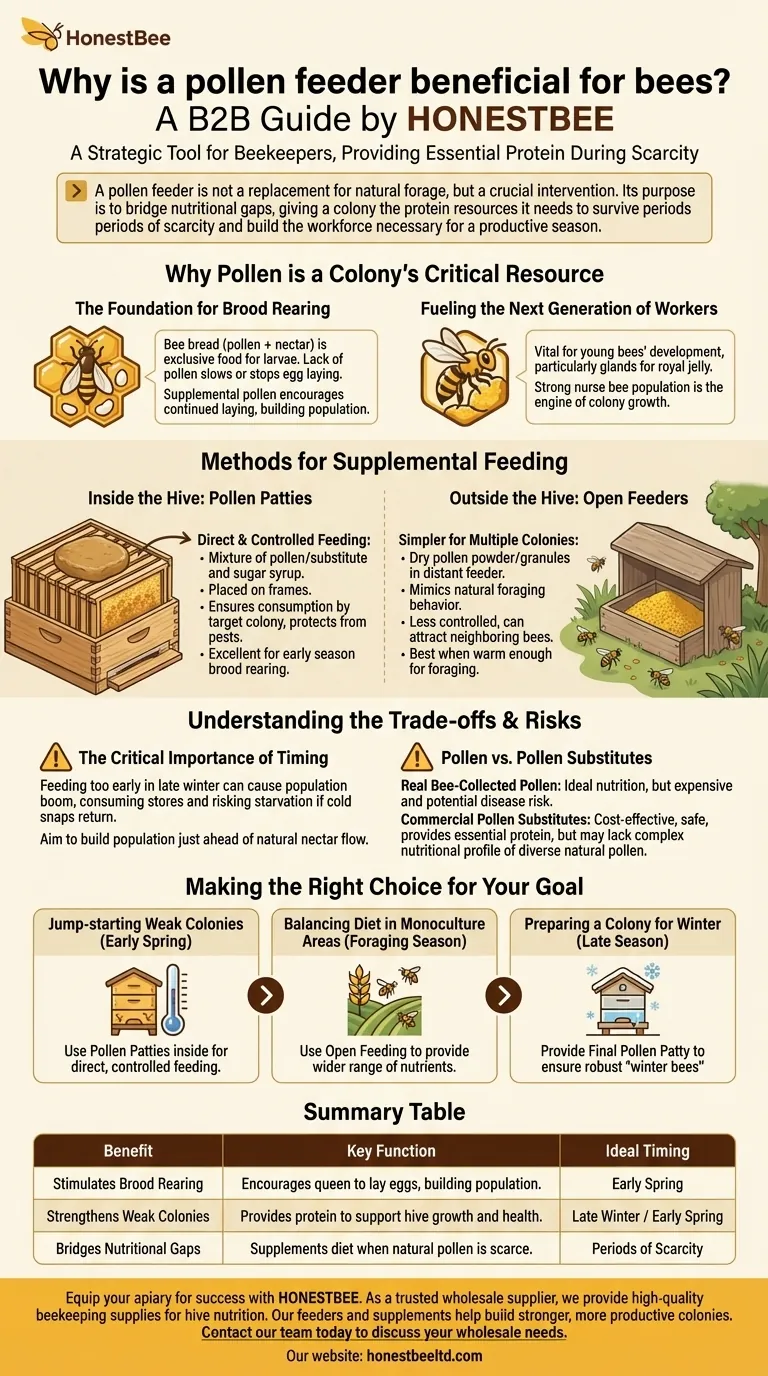In short, a pollen feeder is a strategic tool for beekeepers. It provides essential protein and nutrients when natural pollen is scarce, such as in late winter or early spring. This supplementation helps balance the hive's diet, strengthens weak colonies, and stimulates brood rearing to ensure the colony can build its population ahead of the main nectar flow.
A pollen feeder is not a replacement for natural forage, but a crucial intervention. Its purpose is to bridge nutritional gaps, giving a colony the protein resources it needs to survive periods of scarcity and build the workforce necessary for a productive season.

Why Pollen is a Colony's Critical Resource
Pollen is the primary source of protein, vitamins, minerals, and fats for a honeybee colony. While honey (carbohydrates) provides the energy for adult bees to fly and work, pollen is the foundational nutrient for growth.
The Foundation for Brood Rearing
Bee bread, a fermented mixture of pollen and nectar, is the exclusive food for developing larvae. A lack of incoming pollen signals the queen to slow or even stop laying eggs, as the colony cannot support new members. Providing a supplemental pollen source encourages the queen to continue laying, which is essential for building the hive's population.
Fueling the Next Generation of Workers
Pollen is also vital for newly emerged young bees. Consuming it allows their bodies to fully develop, particularly the glands that produce royal jelly—the substance used to feed the queen and the youngest larvae. A strong, well-fed population of these "nurse bees" is the engine of colony growth.
Methods for Supplemental Feeding
Beekeepers can provide pollen or pollen substitutes in two primary ways, each with distinct applications. The choice depends on your specific goal and hive conditions.
Inside the Hive: Pollen Patties
A pollen patty is a mixture of pollen or a protein-rich substitute combined with sugar syrup to form a soft cake. It is placed directly on top of the frames inside the hive.
This method offers direct and controlled feeding. It ensures the supplement is only consumed by the target colony, protecting it from pests and robber bees from other hives. Patties are excellent for stimulating brood rearing early in the season when it's too cold for bees to fly.
Outside the Hive: Open Feeders
Open feeding involves placing dry pollen powder or granules in a protected feeder some distance away from the hives. This method allows bees to forage for it naturally and carry it back to the hive.
This approach is simpler to manage for multiple colonies and more closely mimics natural foraging behavior. However, it is less controlled, as it can attract bees from neighboring apiaries and other insects. It's best used when the weather is warm enough for foraging.
Understanding the Trade-offs and Risks
While beneficial, pollen feeding must be done with careful consideration. Improper use can create more problems than it solves.
The Critical Importance of Timing
Feeding pollen too early in late winter can stimulate a massive population boom. If a cold snap returns and the bees are unable to forage for nectar, this large new population can quickly consume all the hive's honey stores and starve. The goal is to build the population just ahead of the first natural nectar flow, not months before.
Pollen vs. Pollen Substitutes
Real bee-collected pollen is the ideal nutritional source. However, it can be expensive and carries a small risk of transmitting diseases if not sourced from a reputable, disease-free apiary.
Commercial pollen substitutes are a common, cost-effective, and safe alternative. While they provide the essential protein to stimulate growth, they may lack the complete and complex nutritional profile of diverse, natural pollen.
Making the Right Choice for Your Goal
Use supplemental pollen feeding as a precise tool to address a specific need within your colony.
- If your primary focus is jump-starting a weak colony in early spring: Use pollen patties inside the hive for direct, controlled feeding to encourage brood rearing before natural forage is available.
- If your primary focus is balancing the diet in a monoculture area: Use open feeding during the foraging season to provide a wider range of nutrients than a single crop can offer.
- If your primary focus is preparing a colony for winter: Provide a final pollen patty in the late season to ensure the last generation of bees ("winter bees") is well-fed and robust enough to survive the cold months.
Ultimately, successful pollen feeding is about observing your colony's needs and responding with the right support at the right time.
Summary Table:
| Benefit | Key Function | Ideal Timing |
|---|---|---|
| Stimulates Brood Rearing | Encourages queen to lay eggs, building population. | Early Spring |
| Strengthens Weak Colonies | Provides protein to support hive growth and health. | Late Winter / Early Spring |
| Bridges Nutritional Gaps | Supplements diet when natural pollen is scarce. | Periods of Scarcity |
Equip your apiary for success with HONESTBEE.
As a trusted wholesale supplier for commercial apiaries and distributors, we provide the high-quality beekeeping supplies and equipment you need to manage hive nutrition effectively. Our range of feeders and supplements helps you build stronger, more productive colonies.
Contact our team today to discuss your wholesale needs and ensure your bees have the resources to thrive.
Visual Guide

Related Products
- HONESTBEE Entrance Bee Feeder Professional Hive Nutrition Solution for Beekeeping
- In-Hive Dual Compartment Frame Bee Feeder for Targeted Colony Nutrition
- HONESTBEE Professional Entrance Bee Feeder Hive Nutrition Solution
- Classic Boardman Entrance Bee Feeder Hive Front Feeding Solution
- HONESTBEE Entrance Bee Feeder Efficient Hive Front Liquid Feeding Solution for Beekeeping
People Also Ask
- How do you make an entrance feeder for bees? A Guide to Safe & Effective Hive Feeding
- What is an entrance feeder? A Guide to Its Simple Design and High Robbing Risk
- What are the different types of honey bee feeders? Choose the Right Feeder for Your Hive
- Are entrance feeders good for bees? Prioritize Hive Health Over Convenience
- How does the entrance feeder method work? A Guide to Simple But Risky Hive Feeding



















